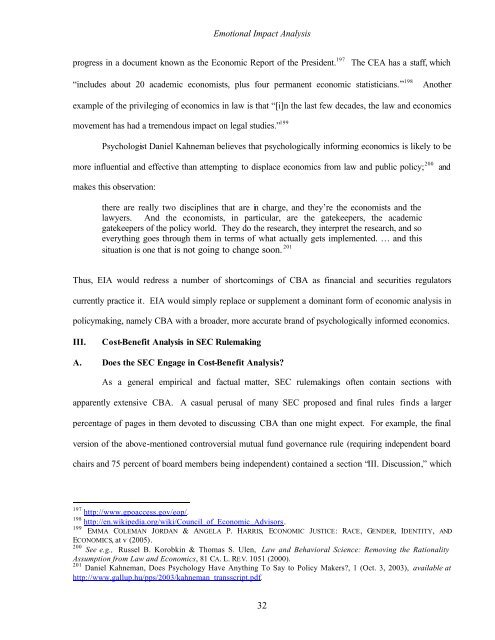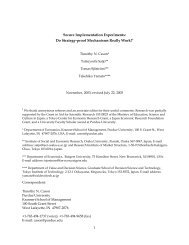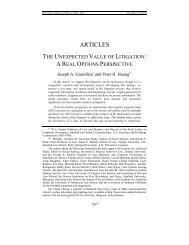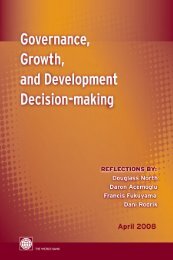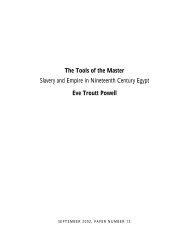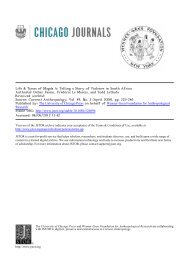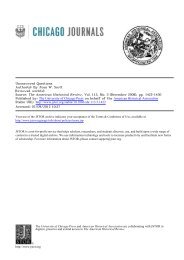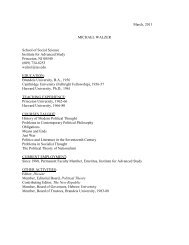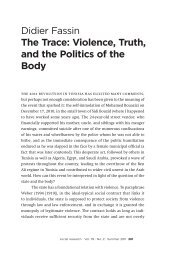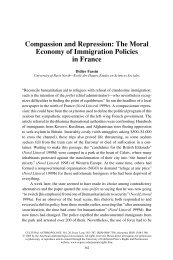Peter H. Huang Harold E. Kohn Chair Professor of Law James ...
Peter H. Huang Harold E. Kohn Chair Professor of Law James ...
Peter H. Huang Harold E. Kohn Chair Professor of Law James ...
Create successful ePaper yourself
Turn your PDF publications into a flip-book with our unique Google optimized e-Paper software.
Emotional Impact Analysis<br />
progress in a document known as the Economic Report <strong>of</strong> the President. 197 The CEA has a staff, which<br />
“includes about 20 academic economists, plus four permanent economic statisticians.” 198 Another<br />
example <strong>of</strong> the privileging <strong>of</strong> economics in law is that “[i]n the last few decades, the law and economics<br />
movement has had a tremendous impact on legal studies.” 199<br />
Psychologist Daniel Kahneman believes that psychologically informing economics is likely to be<br />
more influential and effective than attempting to displace economics from law and public policy; 200 and<br />
makes this observation:<br />
there are really two disciplines that are in charge, and they’re the economists and the<br />
lawyers. And the economists, in particular, are the gatekeepers, the academic<br />
gatekeepers <strong>of</strong> the policy world. They do the research, they interpret the research, and so<br />
everything goes through them in terms <strong>of</strong> what actually gets implemented. … and this<br />
situation is one that is not going to change soon. 201<br />
Thus, EIA would redress a number <strong>of</strong> shortcomings <strong>of</strong> CBA as financial and securities regulators<br />
currently practice it. EIA would simply replace or supplement a dominant form <strong>of</strong> economic analysis in<br />
policymaking, namely CBA with a broader, more accurate brand <strong>of</strong> psychologically informed economics.<br />
III. Cost-Benefit Analysis in SEC Rulemaking<br />
A. Does the SEC Engage in Cost-Benefit Analysis?<br />
As a general empirical and factual matter, SEC rulemakings <strong>of</strong>ten contain sections with<br />
apparently extensive CBA. A casual perusal <strong>of</strong> many SEC proposed and final rules finds a larger<br />
percentage <strong>of</strong> pages in them devoted to discussing CBA than one might expect. For example, the final<br />
version <strong>of</strong> the above-mentioned controversial mutual fund governance rule (requiring independent board<br />
chairs and 75 percent <strong>of</strong> board members being independent) contained a section “III. Discussion,” which<br />
197<br />
http://www.gpoaccess.gov/eop/.<br />
198<br />
http://en.wikipedia.org/wiki/Council_<strong>of</strong>_Economic_Advisors.<br />
199<br />
EMMA COLEMAN JORDAN & ANGELA P. HARRIS, ECONOMIC JUSTICE: RACE, GENDER, IDENTITY, AND<br />
ECONOMICS, at v (2005).<br />
200<br />
See e.g., Russel B. Korobkin & Thomas S. Ulen, <strong>Law</strong> and Behavioral Science: Removing the Rationality<br />
Assumption from <strong>Law</strong> and Economics, 81 CA. L. REV. 1051 (2000).<br />
201<br />
Daniel Kahneman, Does Psychology Have Anything To Say to Policy Makers?, 1 (Oct. 3, 2003), available at<br />
http://www.gallup.hu/pps/2003/kahneman_transscript.pdf.<br />
32


